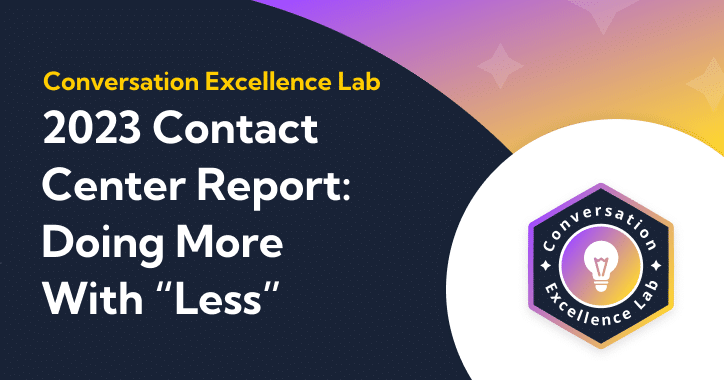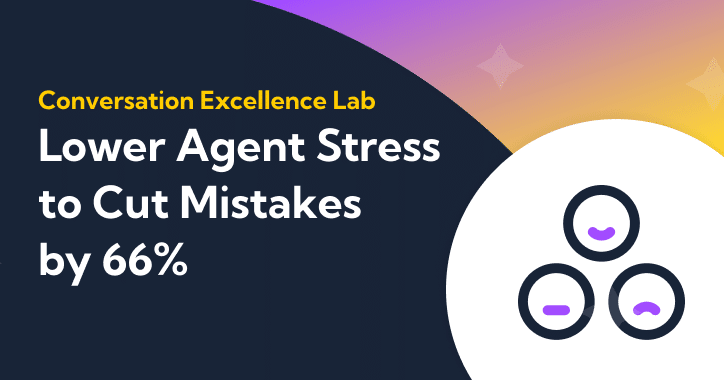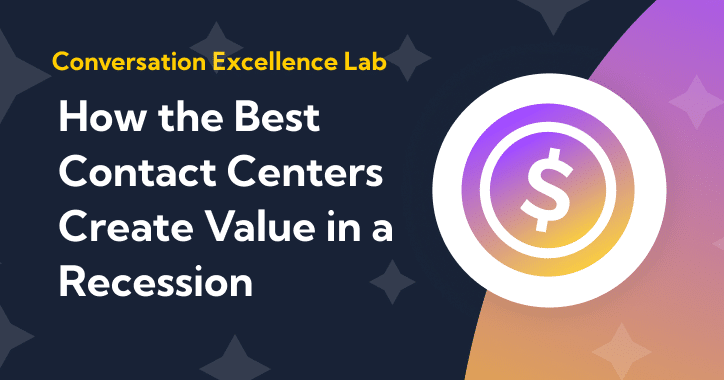A documented wage gap still persists between men and women in the United States. In 2021, for every dollar a male worker earned, female workers earned $.84 on average. The gender pay gap is no simple matter; dozens of possible causes have been proposed in the past 10 years alone.
Our recent survey of over 2,000 contact center workers presented a unique opportunity to explore similar gender disparities across the industry. This report outlines our findings.
Key Takeaways
- A gender pay gap exists in contact centers that is consistent with the national average. The gap persists regardless of industry, education, or age.
- The gap is worse for women of color.
- Despite the gaps, women report being just as satisfied with their pay as men, indicating a need for better conversations about pay rates.
These findings are part of our series on agent attrition in today’s contact centers. Check out our full report here.
Subscribe to future Conversation Excellence Lab reports below:
The Pay Gap Exists in Contact Centers
In our recent report, “7 Industry Insights for the Contact Center,” we stated that contact centers follow the national average gender pay gap. We found that women with salaries earn on average 81.6% of mens’ salaries, while women with hourly wages earn on average 87.4% of men’s wages.
This is consistent regardless of their position, either as front-line workers (agents) or leadership roles (managers, directors, or executives):
- Avg. Salary Front-Line Men: $75,732
- Avg. Salary Front Line Women: $64,537
- Avg. Salary Leadership Men: $89,670
- Avg. Salary Leadership Women: $71,233
- Avg. Hourly Front Line Men: $19
- Avg. Hourly Front Line Women: $17
- Avg. Hourly Leadership Men: $23
- Avg. Hourly Leadership Women: $20
We explored the differences in industries in our recent report, but to summarize: In most industries, men make more than women. On average, salaried men made between $10-15k annually than women, while hourly men earned between $1-2.50 per hour more than women.
Job functions with the highest percentage of women were: Customer Service (70%), Claims (69%), and Collections (57%). Job functions with the highest percentage of men were: Technical Support (72%), Executive Leadership (65%), and Quality Analysis (60%).
Men made more than women across all functions except Lead Generation, which had the smallest sample size of all job functions (28 vs. an average of 183). The functions with the highest pay gaps were Collections (men make $25k more), Sales ($23k), and Quality Analyst ($18k). The function with the lowest pay gap was Customer Service ($432).
Higher Education Doesn’t Solve the Pay Gap
Since 1980, women have steadily outpaced men in college education and have made significant gains in higher-paying jobs. This has helped narrow the gender gap in the overall U.S. economy.
Our survey suggests men still outpace women for educational attainment in the contact center. On a scale of 1-5 with 5 being the highest education level, women averaged a score of 2.99 while men scored 3.38.
But regardless of education level, women still earn less than their male counterparts. Men with high school diplomas made $3,803 more on average than women with high school diplomas. Salaried workers with advanced degrees make up to $15,094 more on average than their female counterparts. For hourly workers, the gap shrinks to $.19 an hour.
Figure 1: Average Salary by Gender and Educational Attainment
Figure 2: Average Hourly Wage by Gender and Educational Attainment
Our survey does not propose a cause for these wage differences, We can, however, consider the following frameworks:
- One proposed explanation for the gender pay gap is that women are steered into particular college majors or career directions based on gender stereotypes. This theory, Occupational Segregation, is well-documented across the U.S. economy.
- Another theory suggests that women may be more likely to hesitate in negotiating a salary during the interview process. One study suggests that men are more likely to negotiate a salary even when the possibility isn’t brought up during interviews.
- Another possibility is simply the discrimination women often face in workplaces. Even when accounting for any possible variables, women often earn less than men immediately after graduating college. Over time, that gap widens.
The Pay Gap Doesn’t Improve With Age
One might assume that as women progress further into their careers, the wage gap would decrease. This is not the case for the national average, and our survey reflects the same.
In the contact center, the wage gap is most narrow for women between the ages of 25 and 34 who earn an hourly wage: they earn $0.91 for every $1 their male counterparts make. After that, the gap widens. This is not reflected for women earning a salary, where the gap stays consistent with the national average regardless of age.
Figure 3: Average Hourly Wage by Gender and Age
Figure 4: Average Salary by Gender and Age
One possible explanation for the widening gap after 34 is the well-documented impact of motherhood on a woman’s career earnings. A 2016 survey found that mothers were twice as likely to report a negative impact on their careers following the start of motherhood. This trend seems just as likely to affect the contact center as any other industry and deserves direct action to fix it. We explore possible actions in our conclusion.
The Pay Gap is Worse for Women of Color
While it’s useful to discuss the gender pay gap based on national averages of all women, it doesn’t fully capture everyone’s experience; for women of color, the pay gap is often much worse than the national average. Our survey reflects this trend.
In the contact center, all women in every racial and ethnic group earn less than the men in the same groups.
Figure 5: Average Hourly Wage by Gender and Ethnicity
Figure 6: Average Salary by Gender and Ethnicity
Since non-Hispanic white men are the most advantaged group in the U.S. labor force, they are a useful benchmark for wage gap comparisons. Based on our survey, Asian women have the smallest wage gap with white men, earning $.95 for every dollar a white man earns when averaging both hourly and salaried workers. Native American women have the largest wage gap, earning only $.52 for every dollar.
Figure 7: Average Amount Earned for Every $1 of Non-Hispanic White Male Earnings
Interestingly, the narrow gap between white men and Asian women also follows suit with larger trends in the U.S. economy. Asian Americans are some of the highest wage earners on average, often eclipsing white men. Our survey suggest the contact center may be a lagging indicator of this trend.
It is important to note that this trend shouldn’t be taken at face value and considered alongside the racial discrimination Asian Americans still regularly face.
Women of color are also the least represented among leadership roles, representing roughly 12% of respondents. Asian, Black, and Hispanic women make up 11% of leadership roles, while Pacific Islander, Native American, and Mixed Race women cumulatively represent 1%. These percentages are well below the national population percentages, which often serve as a gauge for representation in the workplace.
The discrimination and unconscious bias women of color face in the workplace is well documented and could be contributing to the gaps present in contact centers. While we will discuss measures to address wage gaps later on in this piece, it is worth mentioning the effectiveness of anti-bias and -discrimination trainings in the workplace. Companies that prioritize diversity are more profitable, are more attractive to younger employees, and are more innovative.
The Pay Gap May Be Invisible
Despite the strong evidence of a gender wage gap in contact centers, our survey shows that most women are nearly as satisfied with their pay as their male counterparts. On a scale of 1-7 of pay satisfaction, women averaged a score of 5.1; Men averaged a score of 5.5.
While this may seem surprising given the data in this report, it may be the case that women are not always aware of what their male counterparts are earning. It is fair to assume that satisfaction is often a factor of comparison, and the more aware of the wage gap someone is, the less satisfied they will be with their own pay discrepancies.
Surveys have found that many private workplaces in the U.S. actively discourage their employees from discussing their wages. This affects all workers regardless of gender, but actively prevents women from learning more about wage parity with their male colleagues.
Additionally, many employers use past pay history to set a new worker’s pay. For women who are already impacted by the wage gap, this practice could entrench discrepancies even further in their career. It’s possible women would report being satisfied with their pay if they see it as an adequate increase over their previous pay — even if it’s not on par with a male colleague.
Women and Employers Can Help Close the Pay Gap
The contact center is not immune to gender pay gaps, but is capable of making strides to fix it. In their own companies, employers can implement a number of new policies, including:
- Conducting regular pay audits to eliminate any pay disparities.
- Prohibiting retaliation for discussing wages.
- Foregoing an employee’s pay history as a basis of setting their current wage.
- Conducting anti-bias and anti-discrimination training with their hiring personnel.
Individuals and leaders alike can also get involved in groups or initiatives aimed at closing the gender pay gap, including the Washington Center for Equitable Growth, the American Association of University Women, and the The Fawcett Society in the UK. Individuals can also support wage fairness legislation at the state or federal level, such as the 2013 Paycheck Fairness Act.
These actions would not immediately fix a gender wage gap, but would go tremendous lengths to ensure the contact center is an equitable workplace for everyone.
Click here to subscribe to future Conversation Excellence Lab reports.
Sources
American Association of University Women. (2018). The Simple Truth About the Gender Pay Gap. AAUW. Retrieved March 4, 2022, from https://www.aauw.org/app/uploads/2020/02/AAUW-2018-SimpleTruth-nsa.pdf
Balto. (2022, February 15). 7 Industry Insights for the Contact Center – Balto Ai. RSS. Retrieved March 4, 2022, from https://www.balto.ai/research/7-industry-insights/
Balto. (2022, March 29). Contact Center Attrition: What Agents Want in 2022 – Balto Ai. RSS. Retrieved March 4, 2022, from https://www.balto.ai/research/contact-center-attrition-2022/
Barroso, A., & Brown A. (2021, May 25). Gender pay gap in U.S. held steady in 2020. Pew Research Center. Retrieved March 4, 2022, from https://www.pewresearch.org/fact-tank/2021/05/25/gender-pay-gap-facts/
Bersin, J. (2015, December 7). Why Diversity and Inclusion Has Become a Business Priority. Josh Bersin. Retrieved March 4, 2022, from https://joshbersin.com/2015/12/why-diversity-and-inclusion-will-be-a-top-priority-for-2016
Equitable Growth. (2017, October 3). Fact sheet: Occupational segregation in the United States. Washington Center for Equitable Growth. Retrieved March 4, 2022, from https://equitablegrowth.org/fact-sheet-occupational-segregation-in-the-united-states/
Gangl, M., & Ziefle, A. (2009, May). Motherhood, Labor Force Behavior, and Women’s Careers: An Empirical Assessment of the Wage Penalty for Motherhood in Britain, Germany, and the United States. NIH National Library of Medicine. Retrieved March 4, 2022, from https://www.ncbi.nlm.nih.gov/pmc/articles/PMC2831275/
Horowitz, J.M., Parker, K., Graf, N., & Livingston, G. (2017, March 23). Americans Widely Support Paid Family and Medical Leave, but Differ Over Specific Policies. Pew Research Center. Retrieved March 4, 2022, from https://www.pewresearch.org/social-trends/2017/03/23/americans-widely-support-paid-family-and-medical-leave-but-differ-over-specific-policies/
Leibbrandt, A., & List, J.A. (2012, November). Do Women Avoid Salary Negotiations? Evidence From a Large Scale Natural Field Experiment. National Bureau of Economic Research. Retrieved March 4, 2022, from https://www.nber.org/system/files/working_papers/w18511/w18511.pdf
Lorenzo, R., Voigt, N., Tsusaka, M., Krentz, M., & Abouzahr, K. (2018, January 23). How Diverse Leadership Teams Boost Innovation. Boston Consulting Group. Retrieved March 4, 2022, from https://www.bcg.com/en-us/publications/2018/how-diverse-leadership-teams-boost-innovation
Lytle, T. (2019, June 4). Closing the Gender Pay Gap. Society for Human Resource Management. Retrieved March 4, 2022, from https://www.shrm.org/hr-today/news/hr-magazine/summer2019/pages/closing-the-gender-pay-gap.aspx
Martin, E. (2019, July 26). Here’s how much American men earn at every age. CNBC. Retrieved March 4, 2022, from https://www.cnbc.com/2019/07/26/how-much-american-men-earn-at-every-age.html
McKinsey. (2021, September 27). Women in the Workplace 2021. McKinsey. Retrieved March 4, 2022, from https://www.mckinsey.com/featured-insights/diversity-and-inclusion/women-in-the-workplace
Massie, V.M. (2016, July 6). Asian Americans are the highest wage earners. They still face racial discrimination. Vox. Retrieved March 4, 2022, from https://www.vox.com/2016/7/6/12081082/wage-gap-race
Nguyen, V.T. (2020, June 25). Asian Americans Are Still Caught in the Trap of the ‘Model Minority’ Stereotype. And It Creates Inequality for All. Time Magazine. Retrieved March 4, 2022, from https://time.com/5859206/anti-asian-racism-america/
Pew Research Center (2013, December 11). On Pay Gap, Millennial Women Near Parity – For Now. Pew Research Center. Retrieved March 4, 2022, from https://www.pewresearch.org/social-trends/2013/12/11/on-pay-gap-millennial-women-near-parity-for-now/
Semega, J., Kollar, M., Shrider, E.A., & Creamer, J. (2020, September 15). Income and Poverty in the United States: 2019. United States Census Bureau. Retrieved March 4, 2022, from https://www.census.gov/library/publications/2020/demo/p60-270.html
Smith, C., & Turner, S. (2015). The Radical Transformation of Diversity and Inclusion: The Millennial Influence. Deloitte University Leadership Center for Inclusion. Retrieved March 4, 2022, from https://www2.deloitte.com/content/dam/Deloitte/us/Documents/about-deloitte/us-inclus-millennial-influence-120215.pdf
United States Census Bureau. (2020). Quick Facts. United States Census Bureau. Retrieved March 4, 2022, from https://www.census.gov/quickfacts/fact/table/US/PST045221
Cite this report
Balto. (2022, March 4). Missing Cents: Gender Pay Gaps in the Contact Center – Balto Ai. RSS. Retrieved from https://www.balto.ai/research/gender-pay-gaps-in-the-contact-center/






